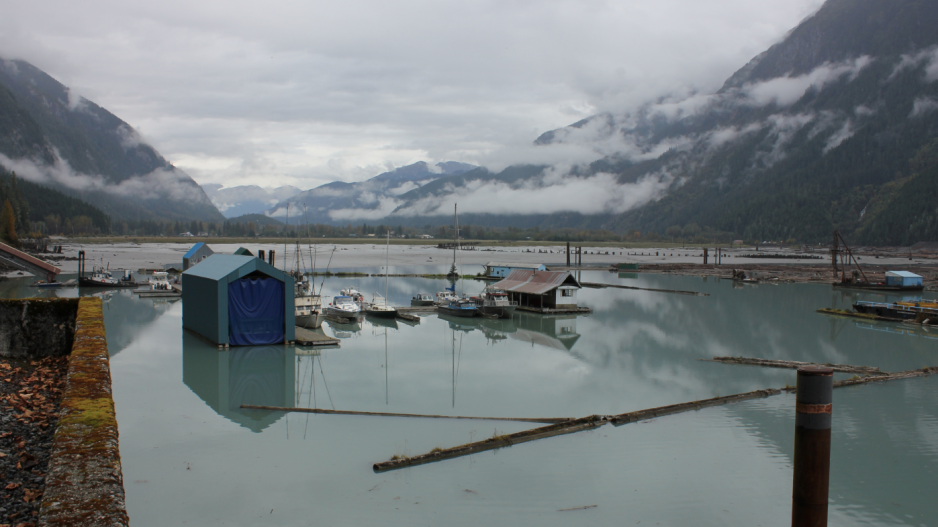The evidence of B.C.’s boom-and-bust natural resource economy is everywhere in Stewart.
There are tidy homes fortressed with wood stacked for the winter and refurbished heritage buildings painted bright colours. But they contrast with the decaying apartments and townhomes in one corner of town, abandoned for decades but never torn down. A few streets away, an elementary school also sits empty, following the consolidation of the high school and elementary school in one building.
The town’s fortunes have ebbed and flowed with the copper, gold and zinc mines that operated in the area starting in the early 1920s. After the Granduc copper mine shut down in the early 1980s, Stewart’s population shrunk to its current size of just 500 people.
Now residents of Stewart are hoping an ambitious plan to develop a port that will capture international business will spur new growth for their community.
The Stewart World Port officially opened September 16 and has secured its first customer, Air Liquide, which will begin shipping materials for use in the Alberta oilsands starting in January. Australian junior miner Atrum Coal also plans to use the port for a new anthracite coal mine it is developing.
The port’s owner, Ted Pickell, expects the bulk of the port’s business to come from shipping concentrate ore from B.C. mines to Asia, but he hopes to become a serious contender for lumber exports as well as imports of materials for the oilsands and other large projects.
Pickell, the owner of Fort St. John construction company Arctic Construction, said he had invested $70 million of his own money so far in the project. He’s planning to add a system to load concentrate ore at a cost of $60 million.
The port is located on land leased from the District of Stewart. Pickell said the port has received no funding from any level of government and the project is debt-free.
The company has a “working relationship” with the Nisga’a First Nation.
The project is proceeding in the headwinds of rock-bottom commodity prices as demand from Asia, and especially China, has slowed. The price plunge has made it difficult for many mines to operate at a profit.

Abandoned houses in Stewart. Following the closure of the Granduc mine in the early 1980s, the town's population shrunk to around 500 people | Jen St. Denis
But potential port customers say that although the location has some drawbacks, the plan is realistic because shippers have few choices in northern B.C., especially for concentrate ore. 
Because of the high shipping volumes, they prefer to ship concentrate ore in bulk (poured directly into the hold of a ship) rather than in containers.
Prince Rupert’s port handles only containers.
Stewart sits at the head of Portland Inlet on the border between B.C. and Alaska. The inlet is deep enough to accommodate Panamax-sized ships and is a day and a half closer to Asia than Port Metro Vancouver, Pickell said.
Kithy Lee, controller for Huckleberry Mines, said her company already ships out of Stewart but welcomes more competition.
Huckleberry uses a terminal designed for concentrate ore that is owned by the Soucies, a local Stewart family.
“We used to have competition with Prince Rupert for concentrate ore, but now Prince Rupert doesn’t have a concentrate port,” she said.

Downtown Stewart | Jen St. Denis
Pickell has taken a gamble, said Anthony Pearkes, the Vancouver-based director of open-hatch and box fleet for Oldendorff, a shipping firm. He believes it’s going to take several years to draw a significant number of customers. The absence of a rail line is also a drawback.

Concentrate from the Huckleberry and Red Chris mines is currently shipped from this terminal | Jen St. Denis
But the lack of competition from other northern ports for bulk and break-bulk cargo means Stewart World Port could grab business from customers who want to ship products like lumber, pulp and ore.
Pickell’s plan to handle cargo for projects like liquefied natural gas or oil pipelines also makes sense because Vancouver is the only other port available for shipping large infrastructure components, Pearkes said.
“Looking at one project our customers seem to have committed to, which is a wind turbine project near tumbler Ridge, it makes a great deal of sense to bring it through here,” Pearkes said.
@jenstden




